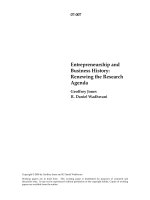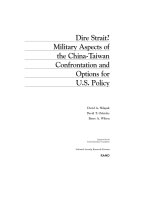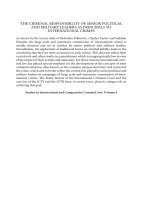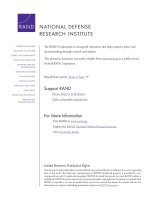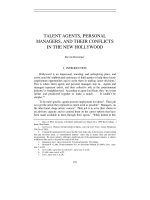Unemployment Among Post-9-11 Veterans and Military Spouses After the Economic Downturn docx
Bạn đang xem bản rút gọn của tài liệu. Xem và tải ngay bản đầy đủ của tài liệu tại đây (395.91 KB, 12 trang )
For More Information
Visit RAND at www.rand.org
Explore the RAND National Defense Research Institute
View document details
Support RAND
Browse Reports & Bookstore
Make a charitable contribution
Limited Electronic Distribution Rights
is document and trademark(s) contained herein are protected by law as indicated in a notice appearing
later in this work. is electronic representation of RAND intellectual property is provided for non-
commercial use only. Unauthorized posting of RAND electronic documents to a non-RAND website is
prohibited. RAND electronic documents are protected under copyright law. Permission is required from
RAND to reproduce, or reuse in another form, any of our research documents for commercial use. For
information on reprint and linking permissions, please see RAND Permissions.
Skip all front matter: Jump to Page 16
e RAND Corporation is a nonprot institution that helps improve policy and
decisionmaking through research and analysis.
is electronic document was made available from www.rand.org as a public service
of the RAND Corporation.
CHILDREN AND FAMILIES
EDUCATION AND THE ARTS
ENERGY AND ENVIRONMENT
HEALTH AND HEALTH CARE
INFRASTRUCTURE AND
TRANSPORTATION
INTERNATIONAL AFFAIRS
LAW AND BUSINESS
NATIONAL SECURITY
POPULATION AND AGING
PUBLIC SAFETY
SCIENCE AND TECHNOLOGY
TERRORISM AND
HOMELAND SECURITY
is product is part of the RAND Corporation occasional paper series. RAND occa-
sional papers may include an informed perspective on a timely policy issue, a discussion
of new research methodologies, essays, a paper presented at a conference, a conference
summary, or a summary of work in progress. All RAND occasional papers undergo
rigorous peer review to ensure that they meet high standards for research quality and
objectivity.
RAND ReseARch AReAs
CHILDREN AND FAMILIES
EDUCATION AND THE ARTS
ENERGY AND ENVIRONMENT
HEALTH AND HEALTH CARE
INFRASTRUCTURE AND
TRANSPORTATION
INTERNATIONAL AFFAIRS
LAW AND BUSINESS
NATIONAL SECURITY
POPULATION AND AGING
PUBLIC SAFETY
SCIENCE AND TECHNOLOGY
TERRORISM AND
HOMELAND SECURITY
This product is part of the
RAND Corporation occasional
paper series. RAND occasional
papers may include an informed
perspective on a timely policy
issue, a discussion of new
research methodologies,
essays, a paper presented at
a conference, a conference
summary, or a summary of
work in progress. All RAND
occasional papers undergo
rigorous peer review to ensure
that they meet high standards for
research quality and objectivity.
© RAND 2012
www.rand.org
Unemployment Among Post-9/11 Veterans and
Military Spouses After the Economic Downturn
Paul Heaton and Heather Krull
e authors express their appreciation to Beth Asch, Jim Hosek, Carrie
Farmer, Marco Angrisani, and Amalia Miller who provided helpful sugges-
tions and comments on this draft.
1
Included among these are the Veterans Employment Initiative initiated
by Executive Order 13518 in 2009, the programs contained within the
VOW to Hire Heroes Act of 2011 (Public Law 112-56), and numerous
programs run by individual agencies, such as the Department of Labor’s
Veterans’ Employment and Training Service program and the Department
of Veterans Aairs’ VetSuccess program.
2
See, for example, Ourmilitary.mil, “Employment Resources for Our
Military Community,” undated; or Joining Forces, “Maintaining the
Momentum—Helping Military Spouses Find Good Jobs in 2012,”
Washington, D.C.: e White House, January 20, 2012.
S
ince the onset of the economic downturn,
policymakers and the public have expressed
renewed concern over veterans who have
served honorably since 9/11—in some cases
experiencing multiple overseas deployments—but
have found it dicult to obtain civilian employ-
ment after completing their military service. In
recent years, legislators and executive branch depart-
ments have proposed a variety of programs aimed
at improving the jobs outlook for recent veterans.
1
ese eorts have been motivated in part by a per-
ception in some quarters that veterans face substan-
tial obstacles to nding civilian employment after
they leave military service. Policymakers have also
expressed concern regarding high unemployment
among spouses of currently serving military person-
nel, with a rate reported to be as high as 26 percent
in some quarters.
2
An important input into policymaking is a clear
understanding of how successful military spouses are
at nding employment and how veterans fare economi-
cally after they exit military service. One common
approach for assessing the performance of these groups
in the job market is to compare their unemployment
rates to those of civilian spouses and nonveterans.
Numerous recent media discussions of the employment
situation of veterans and military spouses have included
such comparisons.
3
However, important dierences in
demographic characteristics between veterans, military
spouses, and civilians counsel caution in comparing
raw employment statistics across these populations.
How Similar Are Post-9/11 Veterans
and Their Spouses to the Civilian
Population?
To illustrate these dierences in demographic charac-
teristics, we analyzed data from the American Com-
munity Survey (ACS). e ACS is a nationally rep-
resentative survey of approximately two million U.S.
households conducted annually by the U.S. Census
Bureau. Designed to replace the decennial Census
long form, the ACS collects information about basic
demographics and housing and economic charac-
teristics of the U.S. population. For this analysis,
we obtained the ACS Public Use Microdata Sample
(PUMS) les for 2010,
4
which include individual
ACS survey responses that have been processed to
preserve respondent condentiality.
For those interested in employment issues for vet-
erans and military dependents, the ACS oers several
advantages over other surveys, such as the Current
Population Survey (CPS), which is the monthly
survey of approximately 50,000 U.S. households con-
ducted by the Bureau of Labor Statistics (BLS) and
used to produce headline unemployment numbers.
e ACS’s comparatively large sample size aords
researchers the opportunity to consider not only the
overall veteran or spouse population but also specic
subpopulations, such as the recently discharged or
O CCASI O N A L
PAPER
NATIONAL DEFENSE
RESEARCH INSTITUTE
O CC ASI O N A L
PAPER
3
For example, see “Iraq, Afghanistan Veterans Struggle to Find Jobs,”
Washington Post, March 11, 2011; “Unemployment Rate Higher for
Veterans an for Non-Veterans,” Chicago Sun-Times, May 29, 2011;
“Making the Sale: How to Deal with Unemployment Among Veterans,”
TIME, August 18, 2011; and “Military Spouses Face Especially Grim Job
Prospects,” NPR, July 28, 2011.
4
At the time of this writing, this was the most recent available year of ACS
microdata.
– 2 –
the husbands of military wives. For example, there
are nearly 5,000 military spouse respondents in the
2010 ACS, whereas the CPS typically contains only a
few hundred military spouses in the monthly survey.
Further, the ACS has a response rate of 98 percent
and samples both household units and group quar-
ters, including such places as college residence halls,
correctional facilities, and military barracks,
5
so it is
highly likely to be representative of the target popula-
tion. is is less likely to be true of voluntary surveys
conducted by the military or the federal government
that have lower response rates and may suer from
nonresponse bias, where the answers of respondents
may dier from the answers that would have been
given by those who did not respond.
6
Table 1 compares the demographic character-
istics of post-9/11 veterans to those of the civilian
population at large. Post-9/11 veterans are dened as
individuals who report having served in the military
at some point after 9/11/2001 but who are no lon-
ger serving in any component of the U.S. military.
7
Relative to civilians, post-9/11 veterans are younger,
more likely to be African American, and more likely
to have college experience. Given that factors such
as age, educational attainment, and race have been
shown in prior research to be highly predictive of
employment status, it seems plausible to expect dif-
ferences in unemployment between veterans and
nonveterans solely as a result of these demographics.
In other words, even if veterans are just as likely as
nonveterans to seek work and employers are equally
willing to hire them, ceteris paribus, we would still
expect to observe a dierent unemployment rate for
post-9/11 veterans and nonveterans because of dif-
Relative to civilians,
post-9/11 veterans
are younger,
more likely to be
African American,
and more likely
to have college
experience.
5
For more information on sampling methodology, see American
Community Survey, “Survey Methodology Main,” Washington, D.C.:
U.S. Department of Commerce, U.S. Census Bureau, undated.
6
For instance, if individuals who are unemployed have more time to
respond to surveys, the set of responses may overrepresent the incidence
Table 1
Demographic Comparisons Between Post-9/11 Veterans and Nonveterans Using the ACS
Characteristic
Average for:
Male Female
Nonveterans
Post-9/11
Veterans Nonveterans
Post-9/11
Veterans
Race
White 0.627
(0.001)
0.683
(0.005)
0.638
(0.001)
0.572
(0.010)
Black 0.117
(0.000)
0.148
(0.004)
0.128
(0.000)
0.230
(0.009)
Hispanic 0.178
(0.001)
0.112
(0.003)
0.154
(0.000)
0.124
(0.007)
Other 0.079
(0.000)
0.057
(0.002)
0.080
(0.000)
0.075
(0.005)
Age 38.5
(0.02)
34.4
(0.09)
40.5
(0.02)
32.4
(0.18)
< age 21 0.106
(0.000)
0.027
(0.002)
0.088
(0.000)
0.044
(0.005)
Ages 21–25 0.119
(0.000)
0.167
(0.004)
0.103
(0.000)
0.197
(0.008)
Ages 26–30 0.113
(0.000)
0.272
(0.004)
0.103
(0.000)
0.302
(0.009)
Ages 31–35 0.105
(0.000)
0.151
(0.003)
0.097
(0.000)
0.161
(0.007)
Ages 36–40 0.107
(0.000)
0.10 0
(0.003)
0.103
(0.000)
0.091
(0.006)
Ages 41 and over 0.451
(0.001)
0.283
(0.004)
0.506
(0.001)
0.204
(0.008)
of unemployment (and overreect the responses of those who are unem-
ployed) in the population.
7
Individuals who served in the National Guard or Reserves are classied
in the ACS as veterans only if they were ever called or ordered to active
duty.
– 3 –
Table 1 (continued)
Demographic Comparisons Between Post-9/11 Veterans and Nonveterans Using the ACS
Characteristic
Average for:
Male Female
Nonveterans
Post-9/11
Veterans Nonveterans
Post-9/11
Veterans
Educational attainment
Less than high school 0.185
(0.001)
0.016
(0.001)
0.135
(0.000)
0.013
(0.002)
High school graduate 0.241
(0.001)
0.212
(0.004)
0.223
(0.001)
0.131
(0.007)
General Equivalency
Diploma
0.043
(0.000)
0.033
(0.002)
0.033
(0.000)
0.016
(0.002)
1 year of college 0.060
(0.000)
0.110
(0.003)
0.073
(0.000)
0.109
(0.006)
>1 year of college, no
degree
0.161
(0.001)
0.281
(0.004)
0.179
(0.000)
0.279
(0.009)
Associate’s degree 0.061
(0.000)
0.111
(0.003)
0.085
(0.000)
0.150
(0.007)
Bachelor’s degree 0.164
(0.000)
0.149
(0.003)
0.180
(0.000)
0.188
(0.008)
Advanced degree 0.086
(0.000)
0.087
(0.002)
0.093
(0.000)
0.114
(0.006)
Region
Midwest 0.216
(0.001)
0.175
(0.004)
0.215
(0.001)
0.149
(0.007)
Northeast 0.186
(0.001)
0.109
(0.003)
0.18 4
(0.000)
0.099
(0.006)
South 0.359
(0.001)
0.478
(0.005)
0.370
(0.001)
0.520
(0.010)
West 0.239
(0.001)
0.238
(0.004)
0.231
(0.001)
0.232
(0.008)
Noncitizen 0.116
(0.000)
0.008
(0.001)
0.092
(0.000)
0.009
(0.002)
Number of children 0.712
(0.002)
0.768
(0.010)
0.748
(0.001)
0.841
(0.022)
Married in past year 0.035
(0.000)
0.068
(0.003)
0.030
(0.000)
0.078
(0.007)
Moved in past year
0.151
(0.001)
0.257
(0.004)
0.151
(0.000)
0.321
(0.010)
Number of observations 810,647 16,783 975,434 3,652
SOURCE: Authors’ calculations from 2010 ACS data.
NOTES: Standard errors are reported in parentheses. For all characteristics except age and number of children, reported
values in the table reflect the fraction of the population with a particular characteristic. Except for the share residing in
the West, for all of these demographic characteristics there is a statistically significant difference between the veteran
average and the nonveteran average.
– 4 –
Spouses of service
members tend
to be younger
and more likely
than their civilian
counterparts to
have had college
experience.
ferences in the demographic composition of the two
populations.
Table 2 provides similar descriptives of military
and civilian spouses. Again, we observe impor-
tant demographic dierences between the military
population and the corresponding civilian com-
parison group. Spouses of service members tend
to be younger and more likely than their civilian
counterparts to have had college experience. ese
dierences counsel considerable caution in directly
comparing military spouses to civilian spouses across
economic outcome measures.
e nal column of Table 2 reports the characteris-
tics of the military spouse population in 2010 as calcu-
lated by the Defense Manpower Data Center (DMDC)
using administrative rather than survey data.
8
e high
8
DMDC, 2010 Military Family Life Project: Tabulations of Responses,
DMDC Report No. 2010-29, Arlington, Va., 2011.
Table 2
Demographic Comparisons Between Military and Civilian Spouses Using the ACS
Characteristic
Civilian Spouse
(ACS)
Military Spouse
(ACS)
Military Spouse
(DMDC)
Male 0.491
(0.001)
0.099
(0.005)
0.05
Race
White 0.722
(0.001)
0.698
(0.008)
0.68
African American 0.070
(0.000)
0.095
(0.005)
0.09
Hispanic 0.132
(0.000)
0.127
(0.006)
0.12
Other 0.076
(0.000)
0.080
(0.005)
0.11
Age
< age 26 0.029
(0.000)
0.232
(0.007)
0.23
Ages 26–30 0.077
(0.000)
0.241
(0.007)
0.26
Ages 31–35 0.108
(0.000)
0.198
(0.007)
0.19
Ages 36–40 0.128
(0.000)
0.146
(0.006)
0.15
Ages 41 and over 0.659
(0.001)
0.183
(0.006)
0.15
Educational attainment
No college 0.351
(0.001)
0.212
(0.007)
0.16
Some college 0.304
(0.001)
0.462
(0.008)
0.49
Bachelor’s degree 0.214
(0.000)
0.220
(0.007)
0.25
Advanced degree 0.130
(0.000)
0.106
(0.005)
0.10
Has children 0.492
(0.001)
0.696
(0.008)
0.72
Number of observations 994,772 5,062
SOURCE: Authors’ calculations from 2010 ACS data.
NOTES: Standard errors are reported in parentheses. Reported table values reflect the fraction of the population with a
particular characteristic.
– 5 –
degree of similarity between the demographics of
military spouses as recorded in the ACS and DMDC’s
tabulations suggests that the ACS does a good job of
capturing a representative sample of this population.
What Do ACS Data Reveal About Post-
9/11 Veteran Employment Patterns?
In addition to providing demographic information, the
ACS includes questions about current work and job
availability that can be used to measure employment
patterns among survey respondents. For this analysis,
we have divided respondents into four mutually exclu-
sive categories—not in the labor force, unemployed,
employed part-time, and employed full-time.
9
We also
present estimates of the unemployment rate for each
population subgroup (post-9/11 veterans and nonvet-
eran civilians), which can be calculated by dividing the
unemployment share by the share in the labor force.
10
Table 3 reports our tabulation of post-9/11 veteran
employment characteristics using the ACS. Column
I reports employment patterns for the overall civil-
ian adult U.S. population—the population typically
used as a reference in media discussions of “headline”
unemployment. As a comparison, unemployment
rates calculated using the CPS suggest that unem-
ployment averaged roughly 9.6 percent over the
entire year.
11
Column II restricts the sample to civil-
ians without prior military service—a common refer-
ence group in discussions of veteran unemployment
and the population shown above in Table 1. Among
nonveterans, roughly one in four is not in the labor
force, and unemployment rates are 10.7 percent.
Column III, which connes the sample to post-
9/11 veterans, shows that unemployment rates are
slightly lower for this population than for the com-
parison civilian population (10.4 percent versus
10.7 percent), although this dierence is not statisti-
cally signicant. However, for each of the individual
employment categories and the overall unemploy-
ment rate, there are statistically signicant dier-
ences across the nonveteran civilian population and
post-9/11 veteran population. For example, post-9/11
veterans are more likely to be in the labor force and
more likely to be employed full-time than are civil-
ians with no prior military service.
However, as argued above, because veterans are
demographically dierent from nonveterans, we
would not necessarily expect these two groups to
Among
nonveterans,
roughly one in
four is not in the
labor force, and
unemployment
rates are
10.7 percent.
9
e ACS does not include the full suite of labor force participation ques-
tions found in the CPS. is means that we unfortunately cannot use ACS
data to identify some subgroups that may be of interest to policymakers,
such as “discouraged workers.” See Nelson Lim and Daniela Golinelli,
Monitoring Employment Conditions of Military Spouses, Santa Monica,
Calif.: R AND Corporation, TR-324-OSD, 2006.
10
is denition is comparable to the BLS “unemployment rate”
commonly referred to in the media, and computed as unemployment
rate = (number unemployed)/(number employed + number unemployed).
11
Holder and Raglin discuss why ACS unemployment questions yield
slightly higher unemployment rates than the BLS questions. Explanations
include dierences in the wording of employment questions across the
two surveys and inconsistencies in the way respondents answer some ques-
tions. See Kelly Holder and Dave Raglin, “Evaluation Report Covering
Employment Status,” 2006 American Community Survey Content Test
Report, Washington, D.C.: U.S. Department of Commerce, U.S. Census
Bureau, 2007, p. 6a.
Table 3
Comparison of Unemployment Between Post-9/11 Veterans and Civilians Using the ACS
Overall U.S.
Civilian Adult
Population
Nonveteran
Civilian
(Unadjusted)
Post-9/11
Veteran
Nonveteran
Civilian
(Adjusted)
Employment Category (I) (II) (III) (IV)
Not in labor force 24.40%
(0.038)
24.29%
(0.040)
15.04%
(0.306)
14.98%
(0.258)
Unemployed 8.01%
(0.025)
8.07%
(0.026)
8.84%
(0.248)
8.44%
(0.175)
Part-time worker 13.97%
(0.031)
14.49%
(0.032)
7.82%
(0.232)
12.08%
(0.222)
Full-time worker 53.61%
(0.044)
53.15%
(0.046)
68.30%
(0.401)
64.50%
(0.301)
Unemployment rate 10.60%
(0.032)
10.66%
(0.033)
10.40%
(0.289)
9.92%
(0.203)
SOURCE: Authors’ calculations from 2010 ACS data.
NOTES: Sample limited to individuals ages 18–65. Standard errors are reported in parentheses.
– 6 –
have the same employment patterns. A dierent
and perhaps more intuitive way to compare the two
groups would be to consider how a typical post-9/11
veteran would fare in the labor market compared
to someone of similar age, educational attainment,
gender, etc., who had no prior military service.
In Column IV, we present estimates of the employ-
ment distribution for a civilian population that have
been adjusted to match the demographic composition
of the post-9/11 veterans. To accomplish this adjust-
ment, we estimated a series of regression models where
the unit of observation was an individual, the out-
come variable was an indicator for a particular type
of employment, and the primary explanatory variable
was an indicator for whether the respondent was a
post-9/11 veteran. e sample was limited to post-9/11
veterans and civilians with no prior military service
(N = 1,710,326), and the regressions also controlled
for respondent race/ethnicity, state of residence, citi-
zenship status, recent marriage, number of children,
mobility, and a full set of gender/marital status/age/
educational attainment/presence of children by age/
Census division/race
12
interactions. Each employment
category was analyzed using a separate regression.
13
Our approach is conceptually similar to matching
each veteran to each of the nonveterans in the sample
who have identical gender, marital status, age, edu-
cational attainment, household presence of children
at dierent ages, race, and region of residence and
then comparing the employment status across each
of these pairs.
14
In conducting such comparisons, we
further adjust statistically for the possibility that the
veterans and matched nonveterans may still dier
across some characteristics that aect employment,
such as citizenship or recent marriage. Column IV
thus allows us to consider a civilian comparison
group with demographic characteristics that are
largely equivalent to those of post-9/11 veterans.
Once we adjust for demographic dierences across
these populations, we observe that unemployment
among post-9/11 veterans is similar to that of demo-
graphically comparable nonveterans (10.4 percent
versus 9.9 percent). Labor force participation is simi-
lar across the two groups, and post-9/11 veterans are
actually more likely than similarly situated civilians
to be employed full- rather than part-time. ese pat-
terns suggest that, on average, recent veterans may
not be faring substantially worse in the labor market
than similar nonveterans.
15
ese results also high-
light the importance of considering demographic dif-
ferences across veteran and nonveteran populations in
formulating policies designed to meet the economic
needs of veterans.
What Do Other Surveys Indicate
Regarding Veteran Unemployment?
We used the ACS for this analysis because the ACS
provides a large sample of post-9/11 veterans and the
best ability to match veterans to otherwise similar
nonveterans. e unemployment patterns we observe
for recent veterans in the ACS appear similar to
unemployment patterns revealed in other surveys.
For example, a BLS report drawing data from a dif-
ferent survey—the CPS—placed the unemployment
rate among post-9/11 veterans in 2010 at 11.5 per-
cent, similar to what we observed in the ACS.
16
One measure of veteran unemployment that has
received considerable attention from policymakers is
the unemployment rate among recent male veterans
ages 18–24, which stood at almost 22 percent in
2010 according to the BLS. e ACS data conrm an
elevated level of unemployment for this population,
although in the ACS, this group’s unemployment rate
is a bit lower at 17.4 percent. However, one reason for
this high unemployment rate among this segment of
the veteran population is that unemployment in gen-
eral tends to be high among young adults. For male
nonveterans ages 18–24, the ACS unemployment
rate in 2010 was 21.6 percent. However, if we use
the matching procedure described above to compute
unemployment among civilians who are demographi-
cally similar to veterans ages 18–24, we obtain an
12
Census divisions are grouping of states into nine areas that are slightly
smaller than regions, e.g., New England and South Atlantic.
13
In theory, one could conduct this analysis using a multinomial model,
but this would be computationally dicult in our case because we have
millions of observations and thousands of xed eects. Moreover, we
would expect the two approaches to yield similar results.
14
is is because the inclusion of a full set of dummy variables capturing
all possible gender/marital status/age/educational attainment/presence of
children by age/Census division/race combinations means that these com-
bined factors are held constant in our regression. So, for example, when we
estimate employment dierences, married 25-year-old African American
female college graduates with no children who live in the South Atlantic
states who are veterans are compared to nonveterans who have that exact
combination of demographic characteristics.
15
Some past studies of veteran unemployment have found that veterans
actually have lower unemployment rates than observationally similar
nonveterans. See D. Black et al., “e Labor Market Outcomes of Young
Veterans,” Chicago Il.: University of Chicago/National Opinion Research
Center Report, September 2008. In addition to using dierent data cover-
ing earlier years, Black et al. (2008) consider unemployment rates over
a longer time horizon, and some evidence suggests the relative position
of veterans improves over time. See David S. Loughran at al., e Eect
of Military Enlistment on Earnings and Education, Santa Monica, Calif.:
RAND Corporation, TR-995-A, 2011.
16
See Economic News Release, “Employment Situation of Veterans
Summary,” Washington, D.C.: U.S. Department of Commerce, U.S.
Census Bureau, March 20, 2012.
. . . on average,
recent veterans
may not be faring
substantially
worse in the labor
market than similar
nonveterans.
– 7 –
unemployment rate of 15.3 percent.
17
ese patterns
suggest that young veterans may indeed face addi-
tional hurdles in the labor market relative to similar
civilians, but high unemployment among this popu-
lation is largely a reection of the fact that they are
young, not that they are veterans.
What Is the Unemployment Rate
Among Military Spouses?
e ACS also permits us to examine employment
patterns among military spouses, furnishing an
independent measure of unemployment for this key
population. Military spouses have typically not been
a focus of BLS studies because relatively few of them
were interviewed in the CPS. Table 4 reports tabula-
tions analogous to those in Table 3 but focusing on
the population of military spouses.
We would expect a lower unemployment rate
among those who are married than in the overall
population,
18
and indeed we observe an unemploy-
ment rate of only 6.4 percent among those married
to civilian spouses, several points below the general
adult rate. Nevertheless, among military spouses,
unemployment is actually above that of the civilian
population, at 12.0 percent. e higher observed
unemployment rate among military spouses persists
after adjusting for demographic dierences between
military and civilian spouses, although the gap nar-
rows somewhat. In addition to experiencing higher
unemployment, labor force participation among mili-
tary spouses is substantially below that of their civil-
ian counterparts.
19
us, the ACS data do support
the notion that military spouses may face hurdles in
obtaining employment beyond those experienced by
similar spouses of civilians.
A number of recent commentaries have cited a
26 percent unemployment rate among military
spouses; this number comes from the 2010 Military
Family Life Project (MFLP), a DoD-sponsored sur-
vey of military families.
20
e ACS data suggest that
the unemployment problem for spouses, although not
insignicant, is much less acute. In particular, the
. . . among
military spouses,
unemployment
is actually above
that of the civilian
population, at
12.0 percent.
17
e 95 percent condence interval for this estimate is 13.1 percent –
17.5 percent.
18
For data on unemployment rates by marital status, see “Labor Force
Statistics from the Current Population Survey: Household Data Not
Seasonally Adjusted,” Washington, D.C.: U.S. Department of Labor,
June 1, 2012, (where among those ages 16+ in the general population,
married men (women) faced an unemployment rate of 5.0 (5.0) percent in
April 2012, versus 9.2 and 13.1 (9.1 and 11.4) percent among widowed/
divorced/separated and never married individuals, respectively.
Table 4
Comparison of Unemployment Between Military Spouses and Civilian Spouses Using the ACS
Overall U.S.
Civilian Adult
Population
Married to
Civilian Spouse
(Unadjusted)
Married to
Military Spouse
Married to
Civilian Spouse
(Adjusted)
Employment
Category
(I) (II) (III) (IV)
Not in labor force 24.40%
(0.038)
20.91%
(0.048)
42.44%
(0.829)
25.53%
(0.385)
Unemployed 8.01%
(0.025)
5.09%
(0.027)
6.93%
(0.407)
5.76%
(0.230)
Part-time worker 13.97%
(0.031)
11.63%
(0.038)
11.82%
(0.526)
16.21%
(0.298)
Full-time worker 53.61%
(0.044)
62.37%
(0.058)
38 .81%
(0.822)
52.49%
(0.454)
Unemployment rate 10.60%
(0.032)
6.44%
(0.034)
12.04%
(0.689)
7.74%
(0.303)
SOURCE: Authors’ calculations from 2010 ACS data.
NOTES: Sample limited to individuals ages 18–65. Standard errors are reported in parentheses.
19
Lim and Schulker document a similar pattern with regard to labor
force participation using the 2006 Survey of Active-Duty Spouses
(ADSS) and CPS data. See Nelson Lim and David Schulker, Measuring
Underemployment Among Military Spouses, Santa Monica, Calif.: RAND
Corporation, MG-918-OSD, 2010. However, they nd a smaller gap in
unemployment between military and civilian spouses, which is likely due
to the earlier time period they studied, when unemployment rates were
generally lower.
20
DMDC, 2011.
– 8 –
estimated unemployment rate for spouses using the
ACS is only about half the MFLP estimate.
21
Conclusions
is paper has provided a snapshot of unemploy-
ment among post-9/11 veterans and military spouses
taken from the 2010 American Community Survey.
Because veterans and military spouses dier from the
civilian population in important ways, comparisons
that adjust for demographic dierences across popu-
lations may be more informative for policymakers
than raw comparisons of unemployment rates would
be. When we make such adjustments using the ACS,
we observe unemployment rates among post-9/11
veterans that are similar to those of their civilian
counterparts. High unemployment rates among
young post-9/11 veterans can be largely attributed to
weakness in the labor market for young adults rather
than for veterans. For military spouses, we observe
unemployment rates in the ACS that are appreciably
above rates for comparable civilians but appreciably
below other published estimates of the unemploy-
ment rate for this population. is snapshot look at
the data suggests that veterans and military spouses
may face important employment obstacles deserving
of policymakers’ attention but also that the situation
may not be as extreme as some headline numbers
would seem to suggest. ■
High unemployment
rates among young
post-9/11 veterans
can be largely
attributed to
weakness in the
labor market for
young adults rather
than for veterans.
21
ere are several potential explanations for this discrepancy. We oer
a couple of suggestions, one of which seems a more plausible explanation
than the other, but more research may be needed to determine the exact
cause for the discrepancy. (1) ere are slight dierences between the
MFLP and the ACS in the questions used to determine employment sta-
tus, but it seems unlikely that these dierences in wording could explain
the large dierences across surveys in calculated unemployment rate.
(2) Because the ACS response rate is 98 percent, dierential response
patterns by employment status are not likely to aect this survey, but if
unemployed military spouses are more likely than those who are working
to respond to the MFLP, this would explain that survey’s higher calculated
unemployment rate. Although DMDC is careful to reweight its MFLP
survey tabulations to the extent possible to account for survey nonresponse,
such reweighting corrections guarantee representativeness only across
dimensions such as age or rank that can be calibrated to an external bench-
mark, and not necessarily for other characteristics such as employment
status for which no nonsurvey estimates exist. Since the ACS has almost no
survey nonresponse, and, as shown in Table 2, is already reective of the
military spouse population, it does not require reweighting corrections.
– 9 –
References
American Community Survey, “Survey Methodology
Main,” Washington, D.C.: U.S. Department of
Commerce, U.S. Census Bureau, undated. As of
June 6, 2010:
/>methodology_main/
Black, D., A. Hasan, P. Krishamurty, and J. Lane,
“e Labor Market Outcomes of Young Veterans,”
Chicago, Il.: University of Chicago/National Opin-
ion Research Center Report, September 2008.
DMDC, 2010 Military Family Life Project: Tabula-
tions of Responses, DMDC Report No. 2010-29,
Arlington, Va., 2011.
Economic News Release, “Employment Situation
of Veterans Summary,” Washington, D.C.: U.S.
Department of Commerce, U.S. Census Bureau,
March 20, 2012. As of June 6, 2012:
Holder, Kelly, and Dave Raglin, “Evaluation Report
Covering Employment Status,” 2006 American
Community Survey Content Test Report, Wash-
ington, D.C.: U.S. Department of Commerce, U.S.
Census Bureau, p. 6a.
“Iraq, Afghanistan Veterans Struggle to Find Jobs,”
Washington Post, March 11, 2011.
Joining Forces, “Maintaining the Momentum—
Helping Military Spouses Find Good Jobs in 2012,”
Washington, D.C.: e White House, January 20,
2012. As of January 27, 2012:
maintaining-momentum-helping-military-spouses-
nd-good-jobs-2012
“Labor Force Statistics from the Current Population
Survey: Household Data Not Seasonally Adjusted,”
Washington, D.C.: U.S. Department of Labor, June 1,
2012. As of June 6, 2012:
/>Lim, Nelson, and David Schulker, Measuring Under-
employment Among Military Spouses, Santa Monica,
Calif.: RAND Corporation, MG-918-OSD, 2010. As
of June 6, 2012:
/>Lim, Nelson, and Daniela Golinelli, Monitoring
Employment Conditions of Military Spouses, Santa
Monica, Calif.: RAND Corporation, TR-324-OSD,
2006. As of June 6, 2012:
/>html
Loughran, David S., Paco Martorell, Trey Miller, and
Jacob Alex Klerman, e Eect of Military Enlistment
on Earnings and Education, Santa Monica, Calif.:
RAND Corporation, TR-995-A, 2011. As of June 6,
2012:
/>html
“Making the Sale: How to Deal with Unemployment
Among Veterans,” TIME, August 18, 2011.
“Military Spouses Face Especially Grim Job Pros-
pects,” NPR, July 28, 2011.
Ourmilitary.mil, “Employment Resources for Our
Military Community,” undated. As of January 27,
2012:
/>employment-resources-for-our-military-community/
“Unemployment Rate Higher for Veterans an for
Non-Veterans,” Chicago Sun-Times, May 29, 2011.
VOW to Hire Heroes Act of 2011, Public Law
112-56.
The RAND Corporation is a nonprofit institution that helps improve policy and decisionmaking through research and analysis. RAND’s publications
do not necessarily reflect the opinions of its research clients and sponsors.
R
®
is a registered trademark.
OP-376-OSD (2012)
RAND publications are available at www.rand.org
About This Paper
is research was conducted jointly by RAND Health’s Center for Military Health Policy Research and the
Forces and Resources Policy Center of the RAND National Defense Research Institute (NDRI), and was
sponsored by the Oce of the Director—Cost Assessment and Program Evaluation, Oce of the Secretary
of Defense. e Center for Military Health Policy Research taps RAND expertise in both defense and health
policy to conduct research for the Department of Defense, the Veterans Administration, and nonprot organi-
zations. NDRI is a federally funded research and development center sponsored by the Oce of the Secretary
of Defense, the Joint Sta, the Unied Combatant Commands, the Navy, the Marine Corps, the defense
agencies, and the defense Intelligence Community. For more information on the Center for Military Health
Policy Research, see or contact the co-directors (contact information
is provided on the web page). For more information on the Forces and Resources Policy Center, see http://
www.rand.org/nsrd/ndri/centers/frp.html or contact the director (contact information is provided on the web
page). e authors can be contacted by mail at the RAND Corporation, 1776 Main St., Santa Monica, CA
90405-2138; or by email at and
R
Headquarters Campus
1776 Main Street
P.O. Box 2138
Santa Monica, C
A
90407
-2138
Offices
Santa Monica, C
A
Washin
gton, D
C
Pitts
burgh, P
A
New Orl
eans, L
A/Jacks
on, M
S
Bosto
n, M
A
Doha, QA
Abu Dhabi, AE
Cambrid
ge, UK
Brussels, B
E
www.rand.org

